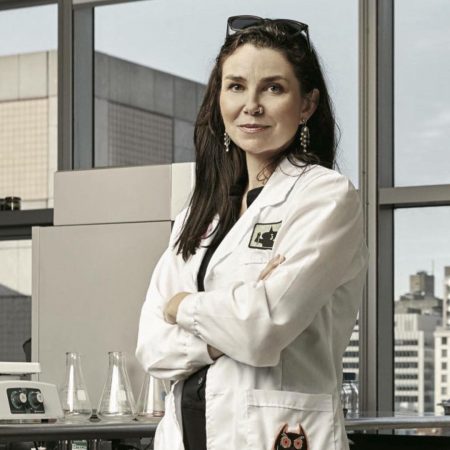You have years of experience working with natural fibres such as silk, which is produced by an organism, and now are developing an established practice in BioArt involving tissue engineering and cell culture. In “Petri dish shibori”, a proliferate bacteria also known as ‘The Blood of Christ” has been allowed to grow within the borders of a stencil that you’ve designed for it. Can you describe your attraction to intelligent microorganisms?
I enjoy incorporating the element of surprise into my creative process, as well as letting go of control. I’m a huge fan of writing by philosopher, Jane Bennett, and her theories about Vibrant Matter, where the agency of nonhuman actors bear an influence on outcomes. The microorganisms I work with are nonhuman actors in my creative process, having the final say on the outcome of the work. These forms of nonhuman intelligence contribute towards creative projects that fall within the categories of post-human, where the anthropocentric focus on individual human actors is given a back seat. I think this is an important framework for creativity, one that asks us to humbly consider other forms of life as relevant influences in the world.
Why is it important to you to desensitize the viewers or general public to the bacteria that lives among them?
I wouldn’t say I’m trying to desensitize viewers, but rather that I’m attempting to highlight the huge role of these tiny actors in our everyday lives, from a perspective of wonder and respect versus our own cultural impetus to control and destroy what we don’t understand. The microorganisms we share space with in the world, even if superficially perceived as pathogenic, have qualities and applications we may not yet have even considered. I’m of the mind that we are a multitude of ‘selves’, which includes many permeable bodies, such as microorganisms. They influence everything from our thoughts and moods to our lifespan. They are us.
How do you access the laboratory, and who are your collaborators?
Currently I have access to two labs: one at the Milieux Institute for Arts, Culture and Technology at Concordia University, where I work as the principal investigator and technician, as well as the Pelling Lab for Biophysical Manipulation at the University of Ottawa, where my main collaborators are. I’ve collaborated with different researchers at Pelling Lab, but my main research squeeze is PhD researcher and biophysicist, Dan Modulevsky, who helps put the scientific standard of “repeatable results” into my bioart practice.
About the Ossa series where you’ve photographed the collected dead animal parts that ‘lived’ in your studio for taxidermy projects, you said that you like to live with the materials for a bit, giving them agency. Is there empathy in working with death, and how do you view life in this context: as a renewal?
I have a respectful fascination with death as a critical part of life. Also, with reference to my longtime practice and academic study of witchcraft, the manipulation of life necessitates an understanding of the material properties of all the stages of the life process. It’s mainly the material nature of bodies that I’m interested in – how bodies behave. I suppose empathy comes in where I lack fear of “dead things” and microbial bodies – empathy is the antidote to fear. Artists often speak of their materials “speaking” to them, to guide the creation of the work. Again, going back to Jane Bennett and Vibrant Matter, part of my role as artist is to observe and allow the materials to do what they seem to want to do.
You have recently ventured into hacking and electronics, how does electronics enhance, change or disrupt your textile practice?
I’m currently very interested in the translation of electronics to soft sculpture and the textile medium, particularly the biotextile medium. In my mind, there’s a feminist intervention into the world of high tech via such a practice, translating wires and circuits and functions to the accessible realm of textiles. Previously I’ve used electronics in the service of the life forms (live biotextiles) I work to maintain in a public setting – the electronics become cyborg appliances serving the life cycles of handmade living craft organisms.
What’s next?
I’ve got several plates of slime mold on the go, as well as vats of cellulose that I’m cultivating in the lab and using as substrates for circuitry. Mainly I’ll be investigating the relationship between living and electronic systems via bioelectricity and ‘live’ wires and switches. Additionally, I’ve got many jars of piss fermenting various lichen species. This is an inquiry into traditional textile “kitchen” labs in conversation with scientific inquiries from a feminist perspective.
